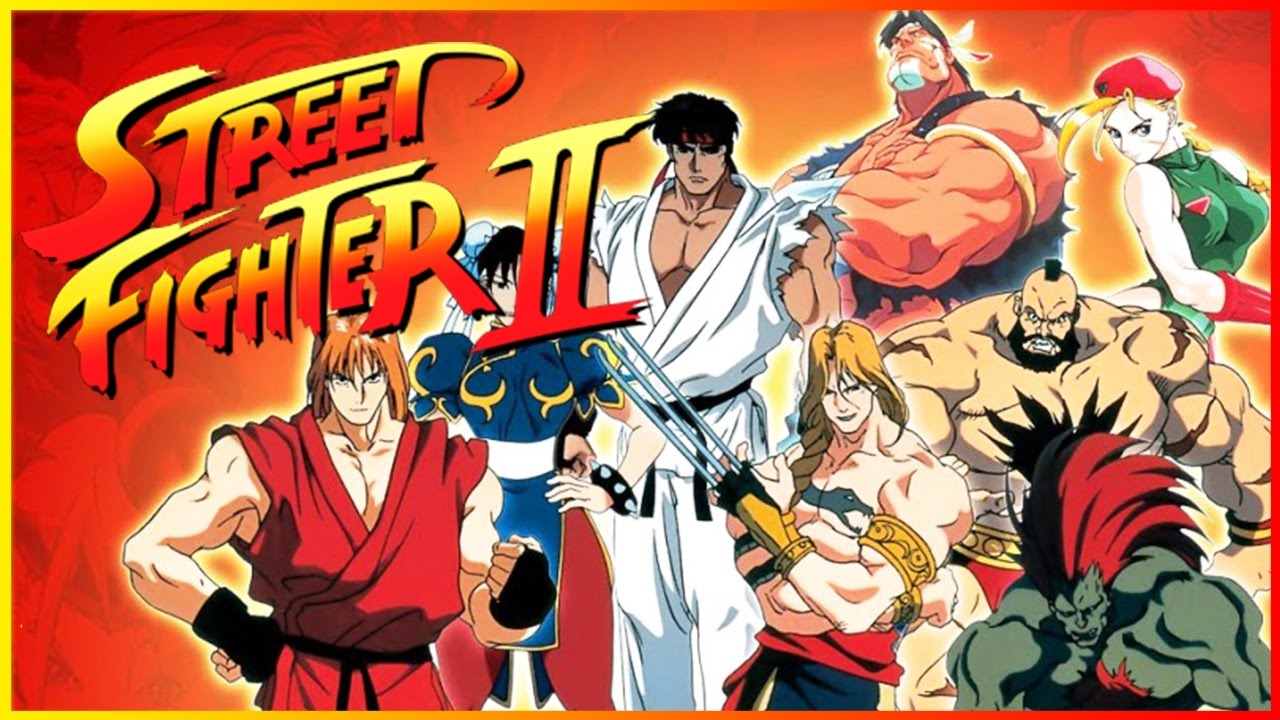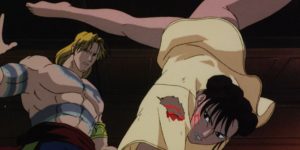The ’90s. Just writing those words makes me think of Pogs and Final Fantasy VII. Zoog Disney, arcades, hugging people – you know? The bygone relics of the ‘before time’.
Hey kids! Remember STUFF? (Image Courtesy USGamer.net)
Something else that the ’90s saw, was the meteoric rise of anime in the United States. For many a nerd, a black nerd especially, anime was a touchstone on our journey like no other. The decade also brought us the greatest genre of fighting ‘vidya’ games in the world: the ‘Vs.’ fighters.
On the surface, these two things seem to only be related in their relative Japanesity (My spellcheck didn’t correct that word so I’m going with it).
In addition to that Japanesity factor, though, these seemingly disparate forms of media cross over in an absolute glut of anime movies and OVAs based on these games – and I’m going to take three and give you the lowdown: just how Japanese is it, should you watch it, and should you even play the game it’s based on?
In today’s classic anime review, we talk about anime adaptations of Vs. fighting games.
That sounded A LOT less specific in my head.
-
Battle Arena Toshinden (Game: 1995, Adapted: 1996)
Fun fact: due to my father’s thick panhandle accent, I thought this game was called “Ballerina Toshinden” until 1997.
Anyway.
The Game: Battle Arena Toshinden is a weapons-based fighter made by Takara. Essentially, it is a street fighter clone where every fighter has some kind of armament in addition to fireballs and grabs. The storyline follows suit; you are a fighter in a fighting tournament trying to out-fight the other fighters. The main characters are Eiji and Kayin, respectively Japanese and Scottish swordsmen, who aim to win the tournament. Kayin seeks to avenge his foster dad, and Eiji is looking for his older brother (think Akuma but with more swords and slightly less pomade).
Slightly. (Image Courtesy SCEA)
The game spawned a handful of sequels and, of course, an anime.
The anime: The 1996 anime of the game is in two parts. The first part begins where the original game ends; Ryu Eiji is fighting Bison Gaia, and the fight is interrupted, leaving no winner to the tournament. From here, Sho (our low-pomade villain) and another villain named Chaos, cause a mess of trouble for our myriad fighting game expys. There’s an amnesiac assassin; a dancer who becomes the object of our heroes’ affections after being poisoned, Orichimaru-style; a robot; a mysterious lady villain named after a planet; and a dude named Iron.
Giant? Blonde? Wields a bat? Named IRON? Go ahead and guess this dude’s nationality. Don’t worry, I’ll wait. (Image Courtesy SCEA)
Enemies become friends, friends become enemies, and there’s enough flash-stepping and explosions to make the most hardcore of Samurai Champloo and Rurouni Kenshin fanboys squee.
So, where does it rank?
I will rank each of these on three factors: originality, quality, and Japanesity. It may seem odd to have quality be only one-third of a review of something’s, well, quality, but you and I both know this ain’t about the merits of these works as games or films. When is the last time YOU played as Viola Davis in a video game?
Exactly. Moving on.
Originality: There are eight default fighters, the main two of which are best friend warriors clad in white and red, one ostensibly Japanese and the other some extant European. Sound familiar? Takara said you can make friends or make money, and then they went straight for the guap. 3/10 originality, because Iron.
I didn’t even mention the camo pants but let’s not pretend you didn’t know. (Image Courtesy SCEA)
Quality: The game is fantastic. It was the first game I owned for the PlayStation and I played it well into owning a PlayStation 2. It paved the way for 3D weapons-based fighters. Soul Calibur comes through this bad boy. It does lose points for not having a single black character, though. You can play it on the PlayStation Classic (available now at the $4 bin at your local car wash!)
The anime is quintessentially 90’s: derivative and spiky. It is, however, actually a pretty faithful adaptation of the game, so if you’re into accuracy, there you go. Both of those pieces of information in mind, I give it a 6/10 for quality.
Japanesity: Takara are also the Japanese manufacturer of Beyblade. This company corners the market on esoteric weeb trash. 10/10.
Overall: I didn’t know how to do a fair overall score so I’m going to take the average of these 3 scores and recommend it based on that. Should you check out this fighter-based anime? The numbers say 6.333… giant bat swings out of 10 that you SHOULD.
I can’t get enough of this nonsense and I apologize for nothing. (Image Courtesy SCEA)
-
Tekken: The Motion Picture (game: 1994, adapted: 1998)
Fun fact: According to Ancestry.Ca, I am a direct descendent of Tekken 7’s Leroy Smith.
The Game: Tekken is a 1994 arcade game made by Namco (now Bandai) and is, arguably, the third pillar of the big 3 fighting game franchises; Street Fighter and Mortal Kombat would be the other two. The game follows the much maligned Mishima family: Kazuya, his father Heihachi, and his son Jin. As the series carries on, we learn of outside kids, a demon patriarch, and a corporate conspiracy. At the beginning, though, we see Heihachi going full Sparta on his weakling child, Kazuya.
I believe the term the kids use is “yeet”. (Image courtesy Bandai Namco)
Our intrepid weakling survives, though, becoming a strongling and taking the family business over from dear old dad. What ensues is, so far, seven games and spinoffs of intrigue, drama, and more fighters and styles than you can shake a stick at. The mechanics are simple but deep, the gameplay styles are diverse, and there are precious few fireballs.
The anime: Tekken has spawned an adaptation called, simply, Tekken: The Motion Picture.
Not you. (Image Courtesy Warner Bros.)
This 1998 feature film centers around several storylines that converge on the King of the Iron Fist tournament, held on a private island owned by the Mishima Corporation. Kazuya seeks revenge on his father, Kazuya’s illegitimate brother Lee seeks his place as the rightful heir, and a swath of agents and assassins seek to expose a criminal plot fronted by the Mishima Corporation. Through the course of the movie we meet a kickboxing mercenary named Bruce; an honest-to-goodness giant robot named Jack (2); and kung-fu cop Lei Wulong, among others. What follows is a jaunt through fight island for fun and profit and justice.
So where does it rank?
Originality: The Tekken franchise is full of style and originality. Visually, the series draws inspirations from countless sources. Mechanically, the game is in a league of its own. The anime is, sadly, a derivative knockoff of Enter the Dragon, albeit with more robots and hair gel.
Gonna fly this fade to the Moon somehow. (Image Courtesy A.D. Vision)
Bearing the game’s innovation in mind, though, I give this 6/10 for originality.
Quality: If this were just ranking the game, this would get an 11/10. The series is 20+ years of out of the park home runs.
We’re not here to rank the game alone, though. And boy howdy, does that suck for these games.
The Toshinden anime was, at least, animated well and voiced competently. Tekken is a mess. It’s clunkily animated, the voices are hokey, and it lacks any of the fun the games have. It is better than its live action counterpart but that’s not saying much. All that in mind, I give this one a 6/10 for quality as well.
Japanesity: Bandai Namco has or had the licenses to make toys for, in no particular order: every anime ever, plus Tamagochi. 10/10.
Overall: The conversation around this game and anime combo will go something like this:
Person 1: “Should I play Tekken 2 or Tekken 5?”
Person 2: “Yes”
Person 1: “Should I watch the animated Tekken or the live action one?”
Person 2: “No”
This one gets 7.333… simple conversations out of 10.
-
Street Fighter II: The Animated Movie (Game: 1991, Adaptation: 1994)
Fun fact: This game has a black character right out of the box!
He looks like Uncle Ruckus got prison muscles, sure, but still. (Image courtesy Capcom)
The Game: Street Fighter II needs no introduction. 1991 saw the release of this arcade vs. juggernaut and it’s been going strong ever since. It has eaten countless quarters, spawned sequels, prequels, and updates, and gave us the greatest “GOTCHA” moment perhaps ever. You know the story: wandering warrior Ryu wanders and wars with warriors (Guile, Chun-Li, E. Honda, Ken, etc.) warring over everything from pride to money to enforcing the law. There’s a tournament arc and a mad dictator and cartoons and movies and and and
And Gomez Addams though, sadly, this will be his only mention. (Image Courtesy Little White Lies)
The Anime: 1994 saw the release of Street Fighter II: the Animated Movie. The same year saw the release of a live-action adaptation, starring the above Gomez Addams and TimeCop.
The anime seeks to adapt the sparse story of (Super) Street Fighter II, sussing out and expounding on Ryu’s journey. While this journey is happening, Air Force Colonel Guile and interpol agent Chun-Li are trying to take down M. Bison and the Shadaloo syndicate.
Image Courtesy 20th Century Fox.
A little over an hour and some of the dopest fight scenes this side of Grappler Baki later and we get a climactic battle with fireballs, mind control, and the real power being the friends we made along the way.
“What do you see beyond your fist?” (Image Courtesy 20th Century Fox)
The definition of a romp, the movie has a satisfying ending that mirrors Ryu’s ending from the video game, walking off into the sunset.
Image Courtesy YouTube
So Where Does It Rank?
Originality: Street Fighter II is your OG’s OG. The animated movie also takes its source material and makes it into something fresh, and it did so before any other fighter. 10/10.
Quality: Definitely the finest quality anime on our list, though there are some super hokey and corny bits in there for that good 90’s flavor. The games, being the OG, didn’t always have the polish that some later franchises would have, and sometimes were not rewarded for being experimental. Overall I give it a 7/10.
Japanesity: Capcom gave us Monster Hunter. 10/10.
Overall: I cannot stress enough that this game and honestly movie are the archetype for this bizarre subgenre. That said, it’s not perfect. It’s close though, at a 9.0 pajama-clad spinning bird kicks out of 10.
All told, it’s like this
Watch these: if you like the games on which they are based. At the very least, you’ll get a chuckle.
Don’t watch these: if you don’t like or have never played the source material. You will likely not get a chuckle.
With that in mind, I give 90’s anime based on arcade-style fighters 7 obscure hobbies out of 10.
Want to get Black Nerd Problems updates sent directly to you? Sign up here.
Follow us on Twitter, Facebook and Instagram!
















Show Comments